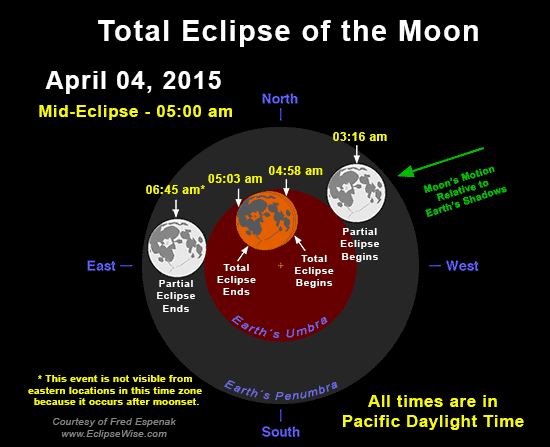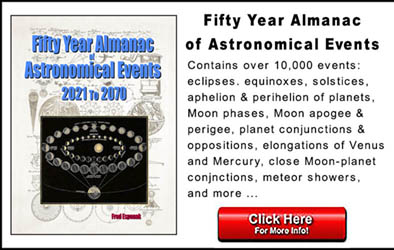Eclipses During 2015
By Fred Espenak
Based on the Article Published in
Observer's Handbook 2015,
Royal Astronomical Society of Canada
In 2015, there are two solar eclipses and two total lunar eclipses as follows.
| Eclipses During 2015 | |||
| 2015 Mar 20: Total Solar Eclipse | |||
| 2015 Apr 04: Total Lunar Eclipse | |||
| 2015 Sep 13: Partial Solar Eclipse | |||
| 2015 Sep 28: Total Lunar Eclipse | |||
| Eclipses During 2015 | |||
|
Total Solar Eclipse 2015 Mar 20 
|
Total Lunar Eclipse 2015 Apr 04 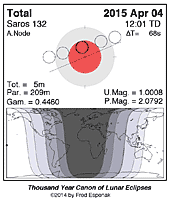
|
Partial Solar Eclipse 2015 Sep 13 
|
Total Lunar Eclipse 2015 Sep 28 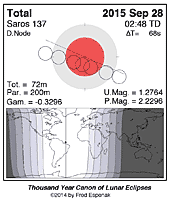
|
Predictions for the eclipses are summarized in Figures 1, 2, 3, and 4. World maps show the regions of visibility for each eclipse. The lunar eclipse diagrams also include the path of the Moon through Earth's shadows. Contact times for each principal phase are tabulated along with the magnitudes and geocentric coordinates of the Sun and Moon at greatest eclipse.
All times and dates used in this publication are in Universal Time or UT. This astronomically derived time system is colloquially referred to as Greenwich Mean Time or GMT. To learn more about UT and how to convert UT to your own local time, see Time Zones and Universal Time.
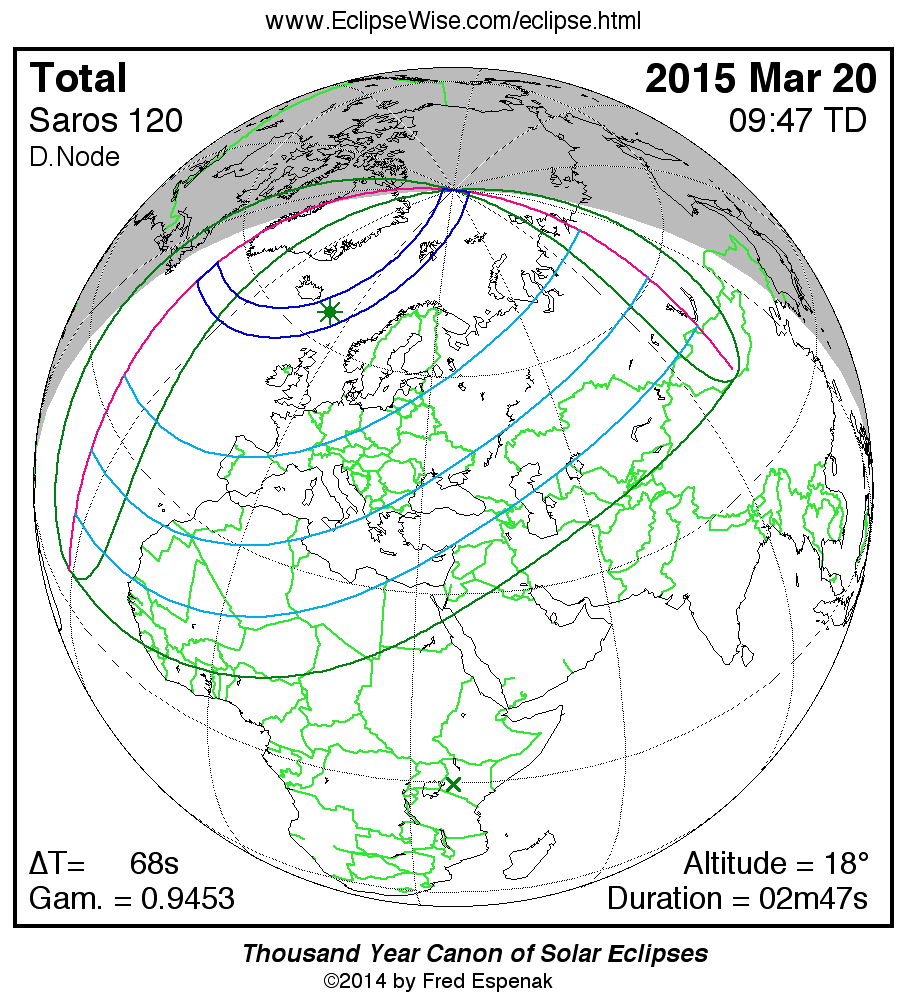
Click for larger more detailed figure
Total Solar Eclipse of 2015 Mar 20
The first eclipse of the year occurs in Pisces at the Moon's descending node just 0.6 days after the Moon reaches perigee. Such a close Moon during a total eclipse usually produces a long duration of totality. But the March 20 event has a large value for gamma [1] of 0.9454. This means that the trajectory of the Moon's umbral shadow takes it to high northern latitudes where Earth's rotation makes a smaller contribution in keeping up with the umbra compared to eclipses near the equator. The end result is that the duration of totality has a maximum value of 2 3/4 minutes, which is about average. Another effect of a large gamma eclipse is that the umbra sweeps across Earth's surface at a steep angle, producing a wide path of totality. In the case of the March 20 eclipse, the path width ranges from 406 to 487 kilometers.
The total eclipse is visible from within a wide corridor that traverses the North Atlantic. A partial eclipse is seen within the much broader path of the Moon's penumbral shadow, which includes Europe, North Africa and western Asia (Figure 1). The central path begins in the North Atlantic about 700 kilometers south of Greenland at 09:13 UT. As the shadow travels east, it curves to the north and misses eastern Iceland by less than 70 kilometers. First landfall of the umbra occurs in the Faroe Islands, a small archipelago of 18 islands situated northwest of Scotland and halfway between Iceland and Norway. In the capital city of Torshavn, totality begins at approximately 09:41 UT and lasts 2 minutes with the Sun 19° above the southeastern horizon. Greatest eclipse [2] occurs at 09:46:47 UT, about 260 kilometers north of the Faroe Islands. The central duration of totality is 2 minutes 47 seconds, the Sun's altitude is 19°, and the path width is 463 kilometers.
Continuing to curve north, the umbra engulfs Svalbard, a Norwegian archipelago situated midway between continental Norway and the North Pole. The capital city of Longyearbyen is located on Spitsbergen, the largest island of Svalbard. The total eclipse begins here at about 10:11 UT and lasts 2 minutes 27 seconds with the Sun at an altitude of 11°. In the remaining few minutes, the shadow path turns due north. The path ends at the North Pole at 10:18 UT as the lunar shadow lifts off Earth and returns to space. During the course of its 1.1-hour trajectory, the umbra's track is approximately 5,800 kilometers long and covers 0.51% of Earth's surface area. Central line coordinates and circumstances are presented in Table 1.
Partial phases of the eclipse are visible primarily from Iceland, Greenland, Europe, North Africa, and western Asia, the Pacific and East Asia. Local circumstances for a number of cities in Europe are found in Table 2a while other locations (Atlantic, Africa and Asia) appear in Table 2b. All times are given in Universal Time. The Sun's altitude and azimuth, the eclipse magnitude [3] and obscuration [4] are all given at the instant of maximum eclipse at each location.
The EclipseWise Javascript Solar Eclipse Explorer is an interactive web page that can quickly calculate the local circumstances for the eclipse from any geographic location not included in Tables 1, 2a and 2b:
Javascript Solar Eclipse Explorer: www.EclipseWise.com/solar/JSEX/JSEX-index.html
This is the 61st eclipse of Saros 120 (Espenak and Meeus, 2006). The family began with a series of 7 partial eclipses starting on 0933 May 27. The first central eclipse was annular and took place on 1059 Aug 11. After 24 more annular and 4 hybrid eclipses, the series changed to total on 1582 Jun 20. Subsequent members of Saros 120 were all total eclipses with maximum durations hovering around 2 minutes. The 2015 Mar 20 eclipse is the 25th total eclipse in the series and actually has one of the longest durations (2 minutes 47 seconds). The next member of the series on 2033 Mar 30 is the last total eclipse of Saros 120. The following 9 eclipses are all partial terminating with the final eclipse of the series on 2195 Jul 07. Complete details for the 71 eclipses in the series (in the sequence of 7 partial, 25 annular, 4 hybrid, 26 total, and 9 partial) may be found at:
www.EclipseWise.com/solar/SEsaros/SEsaros120.html
For additional details on this event, see the EclipseWise Prime Page on the Total Solar Eclipse of 2015 March 20.

Click for larger more detailed figure
Total Lunar Eclipse of 2015 Apr 04
The first lunar eclipse of the year occurs at the lunar orbit's ascending node in Virgo. The apparent diameter of the Moon is smaller than average since the eclipse occurs 3.0 days after apogee (April 01 at 12:59 UT). This is the third of four consecutive total lunar eclipses in 2014 and 2015 (see Lunar Eclipse Tetrads).
The Moon's orbital trajectory takes it through the northern half of Earth's umbral shadow. In this particular case, the entire Moon barely makes it into the umbral shadow leading to a very short total eclipse lasting just 4 1/2 minutes.
The Moon's path through Earth's shadows as well as a map illustrating worldwide visibility of the event are shown in Figure 2. The times of the major eclipse phases are listed as follows.
Penumbral Eclipse Begins: 09:01:25 UT
Partial Eclipse Begins: 10:15:46 UT
Total Eclipse Begins: 11:58:01 UT
Greatest Eclipse: 12:00:16 UT
Total Eclipse Ends: 12:02:32 UT
Partial Eclipse Ends: 13:44:48 UT
Penumbral Eclipse Ends: 14:59:03 UT
At the instant of greatest eclipse [6] (12:00:16 UT) the Moon lies at the zenith for a point in the South Pacific near the Solomon Islands. The umbral eclipse magnitude [7] peaks at 1.0007 as the Moon's northern limb passes less than 2 arc-seconds inside the northern edge of the umbral shadow. This is an extraordinary test test case for a marginally total eclipse.
In contrast, the Moon's southern limb lies 9.4 arc-minutes from the shadow center. As a result, the northern half of the Moon will appear much brighter than the southern half because the Moon samples a large range of umbral depths during the brief total phase. The exact brightness distribution in the umbra is difficult to predict, so observers are encouraged to estimate the Danjon value at mid-totality (see Danjon Scale of Lunar Eclipse Brightness). It may also be necessary to assign different Danjon values to different portions of the Moon (e.g., north vs. south).
During totality, the spring constellations are well placed for viewing so a number of bright stars (and planets) can be used for magnitude comparisons. Spica (m = +1.05) is the most conspicuous star lying 10° southeast of the eclipsed Moon. The brilliant blue color of Spica makes for a striking contrast with the crimson Moon. Arcturus (m = +0.15) is 33° to the north, Saturn (m = +0.3) is 51° to the east, Jupiter (m = -2.3) is 61° to the west, and Antares (m = +1.07) is 56° to the southeast.
The entire event is visible from the Pacific Ocean, Alaska, eastern Australia, New Zealand and Japan. Observers in western North and South America miss the late stages of the eclipse because they occur after moonset. Likewise parts of central and eastern Asia experience moonrise after the eclipse begins so they miss the early stages. None of the eclipse is visible from Europe or Africa.
Table 3 lists predicted umbral immersion and emersion times for 25 well-defined lunar craters. The timing of craters is useful in determining the atmospheric enlargement of Earth's shadow (see Crater Timings During Lunar Eclipses).
The April 04 eclipse is the 30th eclipse of Saros 132. This series began on 1492 May 12 and is composed of 71 lunar eclipses in the following sequence: 8 penumbral, 21 partial, 12 total, 11 partial, and 19 penumbral eclipses (Espenak and Meeus, 2009a). In this context, the April 04 eclipse is the first total eclipse in the series, which helps to explain the barely total nature of the eclipse. The last eclipse of the series is on 2754 June 26. Complete details for Saros 132 can be found at:
www.EclipseWise.com/lunar/LEsaros/LEsaros132.html
For additional details on this event, see the EclipseWise Prime Page on the Total Lunar Eclipse of 2015 April 04.
A special page for the April 04 total lunar eclipse (with additional diagrams, maps, tables) can be found at:

Click for larger more detailed figure
Partial Solar Eclipse of 2015 Sep 13
The second solar eclipse of 2015 occurs in Leo at the Moon's ascending node about 1.2 days before apogee. This partial eclipse is a southern hemisphere event visible from southern Africa, the Indian Ocean and Antarctica (Figure 3).
Local circumstances and eclipse times for a number of cities are listed in Table 4. All times are in Universal Time. The Sun's altitude and azimuth, the eclipse magnitude and eclipse obscuration are all given at the instant of maximum eclipse at each location.
The EclipseWise Javascript Solar Eclipse Explorer is an interactive web page that can quickly calculate the local circumstances for the eclipse from any geographic location not included in Table 4:
Javascript Solar Eclipse Explorer: www.EclipseWise.com/solar/JSEX/JSEX-index.html
This is the 54th eclipse of Saros 125 (Espenak and Meeus, 2006). The series began on 1060 Feb 04 with a string of 12 partial eclipses. The first of 4 consecutive total eclipses began on 1276 Jun 13, followed by 2 hybrid eclipses. The first annular eclipse occurred on 1384 Aug 17. For the next 5 centuries, Saros 125 continued producing annular eclipses. The series reverted back to partial with the eclipse of 1997 Sep 02. It will continue producing partial eclipses foe 3 ½ more centuries until the series ends on 2358 Apr 09. In all, Saros 125 produces 73 solar eclipses in the sequence of 12 partial, 4 total, 2 hybrid, 34 annular, and 21 partial eclipses. Complete details for the series can be found at:
www.EclipseWise.com/solar/SEsaros/SEsaros125.html
For additional details on this event, see the EclipseWise Prime Page on the Partial Solar Eclipse of 2015 September 13.

Click for larger more detailed figure
Total Lunar Eclipse of 2015 Sep 28
The final eclipse of 2015 is another total lunar eclipse, and the last of four consecutive total lunar eclipses spanning two years (see Lunar Eclipse Tetrads). The event is well placed for observers in the Americas as well as Western Europe and Africa. The eclipse occurs in southern Pisces at the Moon's descending node while the Moon is also at perigee (September 28 at 01:46 UT). This means that the Moon will appear 12.9% larger than it did during the April 04 eclipse (33.5 vs. 29.7 arc-minutes).
This time, the orbital path of the Moon takes it deeper into the southern half of Earth's umbral shadow. The total phase lasts 73 minutes - far longer than the brief 4.5-minute duration of the April 04 eclipse. The lunar path through Earth's shadows as well as a map illustrating worldwide visibility of the event are shown in Figure 4. The times of the major eclipse phases are listed as follows.
Penumbral Eclipse Begins: 00:11:46 UT
Partial Eclipse Begins: 01:07:12 UT
Total Eclipse Begins: 02:11:11 UT
Greatest Eclipse: 02:47:09 UT
Total Eclipse Ends: 03:23:07 UT
Partial Eclipse Ends: 04:27:06 UT
Penumbral Eclipse Ends: 05:22:33 UT
At the instant of greatest eclipse (02:47:09 UT) the Moon lies near the zenith from a location near Belem, Brazil. At this time, the umbral magnitude peaks at 1.2765 as the Moon's northern limb passes 3.5 arc-minutes south of the shadow's central axis. In contrast, the Moon's southern limb lies 9.3 arc-minutes from the southern edge of the umbra and 37.0 arc-minutes from the shadow center. As a result, the northern half of the Moon will appear much darker than the southern half because it lies deeper in the umbra. The Moon samples a large range of umbral depths during totality so its appearance will change considerably with time. The exact brightness distribution in the umbra is difficult to predict, so observers are encouraged to estimate the Danjon value at different times during totality (see Danjon Scale of Lunar Eclipse Brightness). It may also be necessary to assign different Danjon values to different portions of the Moon (e.g., north vs. south).
During totality, the autumn constellations are well placed for viewing and the brighter stars can be used for magnitude comparisons. The center of the Great Square of Pegasus lies 24° to the northwest, its brightest star being Alpheratz (m = +2.02). Deneb Kaitos (m = +2.04) in Cetus is 20° south of the eclipsed Moon, while Hamal (m = +2.01) is 35° to the northeast, Aldebaran (m = +0.87) is 65° to the east, and Almach (m = +2.17) is 48° to the north. Although relatively faint, the planet Uranus (m = +5.7) lies 14° northeast of the Moon during totality.
The entire September 28 eclipse is visible from the Atlantic Ocean and regions immediately bordering it. This includes the eastern half of North America, Western Europe, South America and West Africa. From western North America, early eclipse phases occur before moonrise. Similarly, observers in Eastern Europe, the Middle East and East Africa will experience moonset during some phase of the eclipse. None of the eclipse is visible from eastern Asia, Australia or New Zealand.
Table 5 lists predicted umbral immersion and emersion times for 25 well-defined lunar craters. The timing of craters is useful in determining the atmospheric enlargement of Earth's shadow (see Crater Timings During Lunar Eclipses).
The September 28 eclipse is the 26th eclipse of Saros 137. This series is composed of 78 lunar eclipses in the following sequence: 15 penumbral, 8 partial, 28 total, 7 partial, and 20 penumbral eclipses (Espenak and Meeus, 2009a). The family began with the penumbral eclipse of 1564 December 17, and ends with another penumbral eclipse on 2953 April 20. Complete details for Saros 137 can be found at:
www.EclipseWise.com/lunar/LEsaros/LEsaros137.html
For additional details on this event, see the EclipseWise Prime Page on the Total Lunar Eclipse of 2015 September 28.
Lunar Eclipse Tetrads
The lunar eclipses of 2015 are the last of four consecutive total lunar eclipses - a series known as a tetrad. During the 5000-year period from -1999 to +3000, there are 4378 penumbral eclipses (36.3%), 4207 partial lunar eclipses (34.9%) and 3479 total lunar eclipses (28.8%). Approximately 16.3% (568) of all total eclipses belong to one of the 142 tetrads occurring over this period (Espenak and Meeus, 2009a). The mechanism causing tetrads involves the eccentricity of Earth's orbit in conjunction with the timing of eclipse seasons (Meeus, 2004). During the present millennium, the first eclipse of every tetrad occurs sometime from February to July. In later millennia, the first eclipse date gradually falls later in the year because of precession.
Italian astronomer Giovanni Schiaparelli first pointed out that the frequency of tetrads is variable over time. He noticed that tetrads were relatively plentiful during one 300-year interval, while none occurred during the next 300 years. For example, there are no tetrads from 1582 to 1908, but 17 tetrads occur during the following 2 1/2 centuries from 1909 to 2156. The ~565-year period of the tetrad “seasons” is tied to the slowly decreasing eccentricity of Earth's orbit. Consequently, the tetrad period is gradually decreasing (Meeus, 2004). In the distant future when Earth's eccentricity is 0, tetrads will no longer be possible.
The umbral magnitudes of the total eclipses making up a tetrad are all relatively small. For the 300-year period 1901 to 2200, the largest umbral magnitude of a tetrad eclipse is 1.4251 on 1949 Apr 13. For comparison, some other total eclipses during this period are much deeper. Two examples are the total eclipses of 2000 Jul 16 and 2029 Jun 26 with umbral magnitudes of 1.7684 and 1.8436, respectively.
Table 6 gives the dates of each eclipse in the 8 tetrads occurring during the 21st century. The tetrad prior to 2014-15 was in 2003-04 while the next group is nearly 20 years later in 2032-33.
Explanatory Information
Solar Eclipse Figures
Lunar Eclipse Figures
Shadow Diameters and Lunar Eclipses
Danjon Scale of Lunar Eclipse Brightness
Crater Timings During Lunar Eclipses
Eclipse Altitudes and Azimuths
The altitude a and azimuth A of the Sun or Moon during an eclipse depend on the time and the observer's geographic coordinates. They are calculated as follows:
h = 15 (GST + UT - α ) + λ
a = arcsin [sin δ sin φ + cos δ cos h cos φ]
A = arctan [-(cos δ sin h)/(sin δ cos φ - cos δ cos h sin φ)]
where
h = hour angle of Sun or Moon
a = altitude
A = azimuth
GST = Greenwich Sidereal Time at 0:00 UT
UT = Universal Time
α = right ascension of Sun or Moon
δ = declination of Sun or Moon
λ = observer's longitude (east +, west -)
φ = observer's latitude (north +, south -)
During the eclipses of 2015, the values for GST and the geocentric Right Ascension and Declination of the Sun or the Moon (at greatest eclipse) are as follows:
Eclipse Date GST α δ
Total Solar 2015 Mar 20 11.841 23.967 -0.214
Total Lunar 2015 Apr 04 12.833 12.892 -5.289
Partial Solar 2015 Sep 13 23.464 11.398 3.889
Total Lunar 2015 Sep 28 0.438 0.293 1.534
Two web based tools that can also be used to calculate the local circumstances for all solar and lunar eclipses visible from any location. They are the Javascript Solar Eclipse Explorer and the Javascript Lunar Eclipse Explorer. The URLs for these tools are:
Javascript Solar Eclipse Explorer: www.EclipseWise.com/solar/JSEX/JSEX-index.html
Javascript Lunar Eclipse Explorer: www.EclipseWise.com/lunar/JLEX/JLEX-index.html
Eclipses During 2016
In 2016, there are two central solar eclipses and two penumbral lunar eclipses:
| Eclipses During 2016 | |||
| 2016 Mar 09: Total Solar Eclipse | |||
| 2016 Mar 23: Penumbral Lunar Eclipse | |||
| 2016 Sep 01: Annular Solar Eclipse | |||
| 2016 Sep 16: Penumbral Lunar Eclipse | |||
| Eclipses During 2016 | |||
|
Total Solar Eclipse 2016 Mar 09 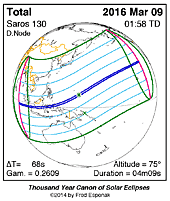
|
Penumbral Lunar Eclipse 2016 Mar 23 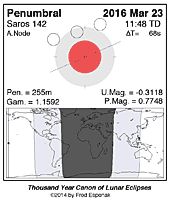
|
Annular Solar Eclipse 2016 Sep 01 
|
Penumbral Lunar Eclipse 2016 Sep 16 
|
A full report Eclipses During 2016 will be published in Observer's Handbook:2016
Eclipse Web Sites
EclipseWise.com is a website dedicated to predictions and information on eclipses of the Sun and Moon. It offers a graphically intuitive interface and contains maps, diagrams, tables, and information about every solar and lunar eclipse from 2000 BCE to 3000 CE. This period includes 11898 solar eclipses and 12064 lunar eclipses.
Much of EclipseWise.com is based on the Thousand Year Canon of Solar Eclipses 1501 to 2500 (Espenak 2014a) and the Thousand Year Canon of Lunar Eclipses 1501 to 2500 (Espenak 2014b). These eclipse predictions use the Jet Propulsion Lab's DE406 — a computer ephemeris used for calculating high precision coordinates of the Sun and Moon for thousands of years into the past and future.
For eclipses over a larger time interval see Five Millennium Canon of Solar Eclipses –1999 to +3000 and Five Millennium Canon of Lunar Eclipses –-1999 to +3000.
The World Atlas of Solar Eclipses provides maps of all central eclipse paths from 2000 BCE to 3000 CE.
MrEclipse.com targets solar and lunar eclipse photography, with tips on eclipse observing and eye safety.
For web versions of this article for other years, visit the following:Acknowledgments
All eclipse predictions were generated on an Apple Power Mac G4 computer using algorithms developed from the Explanatory Supplement [1974] with additional algorithms from Meeus, Grosjean, and Vanderleen [1966]. The solar coordinates used in the eclipse predictions are based on VSOP87 [P. Bretagnon and G. Francou, 1988]. The lunar coordinates are based on ELP-2000/82 [M. Chapront-Touzé and J. Chapront, 1983]. For lunar eclipses, the diameter of the umbral and penumbral shadows were calculated using Danjon's rule of enlarging Earth's radius by 1/85 to compensate for the opacity of the terrestrial atmosphere; corrections for the effects of oblateness have also been included. Text and table composition was done on a Macintosh using Microsoft Word. Additional figure annotation was performed with Claris MacDraw Pro.
All calculations, diagrams, tables, and opinions presented in this paper are those of the author, and he assumes full responsibility for their accuracy.
Permission is granted to reproduce the eclipse data when accompanied by a link to this page and an acknowledgment:
"Eclipse Predictions by Fred Espenak, EclipseWise.com"
The use of diagrams and maps is permitted provided that they are unaltered (except for re-sizing) and the embedded credit line is not removed or concealed.
Footnotes
[1] Gamma is the distance of the Moon's shadow axis from Earth's center (in Earth radii) when it reaches its minimum absolute value.
[2] The instant of greatest eclipse for lunar eclipses occurs when the distance between the Moon's shadow axis and Earth's geocenter reaches a minimum.
[3] Eclipse magnitude for solar eclipses is defined as the fraction of the Sun's diameter occulted by the Moon.
[4] Eclipse obscuration is defined as the fraction of the Sun's area occulted by the Moon.
[5] The Saros is a period of 6,585.3 days (18 years 11 days 8 hours) in which eclipses (both solar and lunar) repeat. The geometry isn't exact but close enough for a Saros series to last 12 or more centuries.
[6] The instant of greatest eclipse for lunar eclipses occurs when the distance between the Moon's shadow axis and Earth's geocenter reaches a minimum.
[7] Umbral eclipse magnitude is defined as the fraction of the Moon's diameter occulted by the umbral shadow.
[8] The sub-solar point is the geographic location where the Sun appears directly overhead (zenith).
[6] Eclipse obscuration is defined as the fraction of the Sun's area occulted by the Moon.
References
Bretagnon P., Francou G., "Planetary Theories in rectangular and spherical variables: VSOP87 solution", Astron. and Astrophys., vol. 202, no. 309 (1988).
Chapront-Touzé, M and Chapront, J., "The Lunar Ephemeris ELP 2000," Astron. and Astrophys., vol. 124, no. 1, pp 50-62 (1983).
Chauvenet, W., Manual of Spherical and Practical Astronomy, Vol.1, 1891 (Dover edition 1961).
Danjon, A., "Les éclipses de Lune par la pénombre en 1951," L'Astronomie, 65, 51-53 (Feb. 1951).
Espenak, F., Fifty Year Canon of Solar Eclipses: 1986–2035, Sky Publishing Corp., Cambridge, MA, 1988.
Espenak, F., Fifty Year Canon of Lunar Eclipses: 1986–2035, Sky Publishing Corp., Cambridge, MA, 1989.
Espenak, F., and Meeus, J., Five Millennium Canon of Solar Eclipses: –1999 to +3000 (2000 BCE to 3000 CE), NASA TP–2006-214141, Goddard Space Flight Center, Greenbelt, MD, 2006.
Espenak, F., and Meeus, J., Five Millennium Canon of Lunar Eclipses: –1999 to +3000 (2000 BCE to 3000 CE), NASA TP–2009-214172, Goddard Space Flight Center, Greenbelt, MD, 2009a.
Espenak, F., and Meeus, J., Five Millennium Catalog of Lunar Eclipses: –1999 to +3000 (2000 BCE to 3000 CE), NASA TP–2009-214173, Goddard Space Flight Center, Greenbelt, MD, 2009b.
Espenak, F., and Meeus, J., Five Millennium Catalog of Solar Eclipses: –1999 to +3000 (2000 BCE to 3000 CE), NASA TP–2009-214174, Goddard Space Flight Center, Greenbelt, MD, 2009c.
Espenak, F., Thousand Year Canon of Solar Eclipses 1501 to 2500, AstroPixels Publishing, Portal, AZ, 2014.
Espenak, F., Thousand Year Canon of Lunar Eclipses 1501 to 2500, AstroPixels Publishing, Portal, AZ, 2014.
Explanatory Supplement to the Astronomical Ephemeris and the American Ephemeris and Nautical Almanac, Her Majesty's Nautical Almanac Office, London, 1974.
Littmann, M., Espenak, F., & Willcox, K., Totality—Eclipses of the Sun, 3rd Ed., Oxford University Press, New York, 2008.
Meeus, J., Mathematical Astronomy Morsels III, Ch. 21, Willmann-Bell, Richmond, 2004.
Meeus, J., Grosjean, C.C., & Vanderleen, W., Canon of Solar Eclipses, Pergamon Press, New York, 1966.
Meeus, J. & Mucke, H., Canon of Lunar Eclipses: -2002 to +2526, Astronomisches Buro, Wien, 1979.

